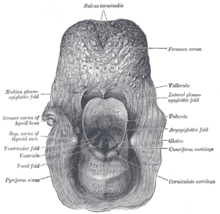Hypopharynx
The hypopharynx (from the Greek; ὑπό (hypό) = below, below and φάρυγξ (Phárygx) = throat, throat) is an area in the head / neck area of animals and humans . In mammals , the hypopharynx or laryngopharynx refers to the lowest part of the throat ( pharynx ) from the upper edge of the epiglottis to the upper esophageal mouth or an imaginary line at the level of the cricoid of the larynx (larynx). The hypopharynx is divided into 3 areas: piriform sinus , posterior wall of the hypopharynx and post-cricoid region.
In insects , the hypopharynx is an appendix to the head capsule that attaches below the mouth opening. This is not a real mouth tool as it was not formed from former extremities . The hypopharynx is originally a membranous structure that can be moved like a tongue, for this reason it is often referred to as the lingula (tongue). This structure is moved by basal muscles , which attach to the chitin protrusions of the hypopharynx, so-called basal sclerites. The position of the hypopharynx divides the mouth opening into an anterior oral cavity and a posterior area in which the labial glands open. Like the mandibles , maxillae and labium of the mouth , the hypopharynx is also converted into different groups of insects, for example into a piercing bristle or parts of a proboscis . Opposite it, at the top of the mouth opening, is the epipharynx .

